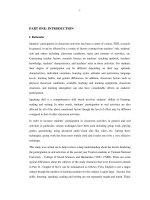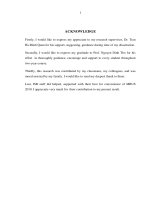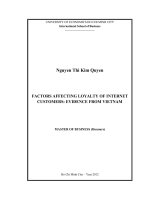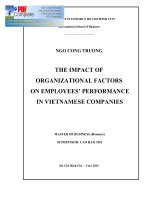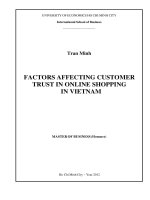FACTORS AFFECTING CUSTOMER TRUST IN ONLINE SHOPPING IN VIETNAM
Bạn đang xem bản rút gọn của tài liệu. Xem và tải ngay bản đầy đủ của tài liệu tại đây (504.46 KB, 67 trang )
UNIVERSITY OF ECONOMICS HO CHI MINH
CITY
International School of
Business
Tran Minh
FACTORS AFFECTING CUSTOMER
TRUST IN ONLINE SHOPPING
IN VIETNAM
MASTER OF BUSINESS
(Honours)
Ho Chi Minh City – Year 2012
Ho Chi Minh City – Year
2012
UNIVERSITY OF ECONOMICS HO CHI MINH
CITY
International School of
Business
Tran Minh
FACTORS AFFECTING CUSTOMER
TRUST IN ONLINE SHOPPING
IN VIETNAM
ID: 60340102
MASTER OF BUSINESS (Honours)
SUPERVISOR:
Dr. NGUYEN HUU LAM
Ho Chi Minh City – Year 2012
i
Acknowledgement
Apart from the efforts of me, the success of this thesis is depended largely on
the encouragement and guidelines of many others. Especially, Dr. Nguyen Huu Lam
and Associate Prof Dr. Nguyen Dinh Tho have been instrumental in the successful
completion of this study. I would like to take this opportunity to express my gratitude
to them and I really appreciate with their tremendous support and help. I feel motivated
and encouraged every time I attend his meeting. Without his encouragement and
guidance, this project would not have materialized.
Besides, I would like to thank my close classmates and staffs working at
International School of Business – UEH including Nguyen Thanh Huong, Huynh Ngoc
Duy, Thai Thi Thu Giang, and Nguyen Thi Ngoc Lien for their guidance and support.
Ho Chi Minh City, Jan 1
st
2013
Tran Minh
ii
Table of Contents
Abbreviations iii
List of Tables iv
List of Figures v
List of Appendix vi
Chapter One: Introduction 1
1. Background 1
1.1. The Internet in Vietnam 1
1.2. Online shopping in Vietnam 1
2. Statement of purpose 2
3. Research question 3
4. Significance of the study 3
5. Scope of the study 3
6. Structure of the study 3
Chapter Two: Literature Review 5
1. Trust in online shopping 5
1.1. Definition of trust in e-commerce 5
1.2. The importance of trust in e-commerce 15
2. Trust antecedents identified in the literature 16
2.1. Perceived privacy and security protection 16
2.2. Perceived risks and benefits 18
Chapter Three: Methodology 20
1. Participants 20
2. Instruments 20
3. Samples and data collection procedures 24
4. Data analysis 24
Chapter Four: Results 26
1. Characteristics of the sample population 26
2. Reliability of measurement instruments 28
iii
2.1. Validating measures 28
2.2. Exploratory factor analysis 32
3. Tests of regression assumptions 37
3.1. Test of multicollinearity 37
3.2. Test of normality of residual & heteroscedasticity 38
4. Evaluating demographic variables’ impacts on customers’ trust 38
5. Hypotheses testing 39
6. Summary of the results 41
Chapter Five: Discussion 43
1. Findings 43
2. Implications 44
3. Conclusion 45
4. Limitations and directions for future research 45
References 46
iii
Abbreviations
WTO World Trade Organization
APEC Asia-Pacific Economic Cooperation
ASEM Asia-Europe Meeting
SPSS Statistical Package for the Social Sciences
PP Privacy Protection
SP Security Protection
PR Perceived Risk
PB Perceived Benefit
CTIS Customer Trust in Internet Shopping
EFA Exploratory Factor Analysis
TVE Total Variance Extracted
VIF Variance Inflation Factor
iv
List of Tables
Table 2.1. Summary of prior conceptualizations of trust 6
Table 3.1. Privacy protection and security protection scales 21
Table 3.2. Perceived risk and perceived benefits scales 22
Table 3.3. Customer trust scale 23
Table 4.1. Distribution of respondents based on demographic characteristics 27
Table 4.2. Item-Total Statistics 29
Table 4.3. Total Variance Explained 34
Table 4.4. Pattern Matrix
a
35
Table 4.5. Item-Total Statistics 36
Table 4.6. Model Summary 39
Table 4.7. ANOVA
b
39
Table 4.8. Coefficients
a
40
v
List of Figures
Figure 1. Conceptual Model 19
Figure 2. Results of testing the conceptual model 42
vi
List of Appendix
Appendix A. Customer Survey Form 51
Appendix B. Graphs 57
Graph 1. Regression Standadized Residual 57
Graph 2. Normal P-P plot of regression standardized residual 57
Graph 3. Scatterplot 58
1
Chapter One: Introduction
1. Background
1.1. The Internet in Vietnam
It has been more than one decade since the Internet started to have been used in
Vietnam. Vietnam connected the world in 2000, the Internet users was a small figures,
just 0.3% of the population in 2000. However, the Internet is growing fast, much faster
than in any other Asian countries in 2011. Over the last ten years 2000-2010, Internet
usage has grown by 12.4 times in Vietnam. This is the highest level of penetration in
the Asian countries. After five years from 2000, this number was up to 12.8%; and
17.9% in 2007; 24.0% in 2008; and 25.7% of Vietnam population in 2009.
Impressively, este et al. (2012) suggest that a large number of Vietnamese Internet
users accounted for 30.8 million at the end of Feb 2012, equivalent to 34% of Vietnam
population. More and more people are online and in Vietnam, they spend a massive
amount of time on the Internet. There is a huge, targetable population of consumers
online. As to Feb 2012, 30.8 million Vietnamese people can be reached on the Internet,
with a strong growth every year. In addition, these are not just the teenagers, but also
more and more also their parents and in general, the household decision makers, an
interesting target audience for marketing activities. They are also increasingly
comfortable with making purchases online.
1.2. Online shopping in Vietnam
The internet is changing the way consumers shop and buy goods and services,
and has rapidly evolved into a global phenomenon and even in Vietnam. Many
companies have started using the Internet with the aim of cutting marketing costs,
thereby reducing the price of their products and services in order to stay ahead in
highly competitive markets. Customers use the Internet not only to compare prices,
2
product features, after sale service facilities they will receive, but they can save time
and cost for buying products from a particular store. In 2010, every second Internet
user in Vietnam has already visited sites that offer online shopping, buy and sell
activities or auctions. Este et al. (2012) suggest that the most of customers purchasing
online is just a small piece of big potential e-commerce market and online shopping
activities are mainly common in the north and in big cities, whilst in smaller cities it is
not yet frequent. Hanoi is the undisputed leader in e-commerce with 60 per cent of
Hanoi net citizens using these sites.
To advance its e-commerce to improve businesses’ competitiveness thus
boosting the country’s industrialization and modernization, Vietnam government
approved a plan on e-commerce for the next 5 years 2011 – 2015 last year. This
decision helps concretize Vietnam’s commitments for international integration with
WTO, APEC and ASEM. Although e-commerce purchases in early stage market in
Vietnam, the high young generation population and great coming opportunities closer
promises the strongest growth in online shopping area. However, the major problem in
the area of online shopping is the low confidence in online payment systems. Este et al.
(2012) suggest that one of the key factor to explain for this is that people does not trust
in Internet shopping. Therefore, studying trust is considered as a vital key for
individuals or organizations to maintain and build customer’s trust so in Internet
shopping that the growth of e-commerce can be speeded up for the coming years in
Vietnam.
2. Statement of purpose
This study aims to identify which ones of the four antecedents of trust (privacy
protection, security protection, perceived risk, and perceived benefits) have impacts on
customer trust in online in shopping in Vietnam.
3
3. Research question
Is customers’ trust affected by perceptions about privacy, security protection,
perceptions about the risks and benefits during the transaction on the Internet.
4. Significance of the study
In terms of theory, this study provides an empirical understanding role of factor
trust towards online shopping; And in terms of practice, this study presents strategic
implications and directions for the development of online shopping in Vietnam.
5. Scope of the study
The study focuses on collecting people having experience in the online shopping
Ho Chi Minh City. The city is selected due to the highest Internet penetration rate. Este
et al. (2012) suggest that the Internet penetration rate is more than 50% the population
have used the Internet already in urban Vietnam. The city is higher than the average
rate of 50% of the population with the rate 62% in 2011.
6. Structure of the study
The thesis consists of five chapters. Chapter 1 introduces an overview of the
background, statement of purpose, research question, the significance of the study, and
scope of the study. Chapter 2 reviews existing literature on trust, online customer trust,
and the four antecedents of trust. These literatures summarize briefly the knowledge of
recent studies, describes the conceptual model, and hypotheses. Chapter 3 presents who
participate in this study, instruments used to measure the research constructs, the
description of the samples, data collection procedures and data analysis. Chapter 4
describes characteristics of the sample. In addition, validity and reliability of measures
will be checked by coefficients of Cronbach‘s Alpha and EFA (Principle Axis
Factoring with Promax). Then testing the assumption of regression, evaluating
4
demographic variables’ impacts on customers’ trust, and testing hypotheses are
presented. Chapter 5 presents discussions on the research findings. Theoretical
contributions, practical implications, and limitations of the current research are also
discussed. Suggestions for future research will conclude this dissertation.
5
Chapter Two: Literature Review
1. Trust in online shopping
1.1. Definition of trust in e-commerce
Trust definition in Internet shopping is a quite complicated concept in e-
commerce field. Depending on different contexts, researchers offer different meanings.
As Table 2.1 shows below, trust is viewed as 1). A set of specific beliefs (Doney &
Cannon 1997; Ganesan 1994). 2). A general belief that another party can be trusted
(Gefen 2000; Hosmer 1995; Moorman et al. 1992) 3). Affect reflected in “feelings” of
confidence and security. 4). A combination of three elements mentioned above. Based
on trust objects, trust has been conceptualized as a specific and general belief. Some of
them describe the specific beliefs as antecedents to the general beliefs (Jarvenpaa and
Tractinsky, 1999; Mayer and Davis, 1999; Mayer et al., 1995; Jarvenpaa and
Tractinsky, 1999) or sometimes conceptualize the specific beliefs as antecedents to
trusting intentions (McKnight et al., 1998). The others conceptualize trust as general
beliefs in e-commerce contexts that leads to behavorial intentions (Gefen, 2000); as a
combination of intergrity and caring that leads to an increase in behavioral intentions to
vulnerability (Javenpaa and Tractinsky, 1999); as a specific belief dealing with
benevolence, competence, and intergrity that results in trusting intentions (McKnight et
al., 2002).
However, the distinction between trust as a set of specific and general belief is
primarly happened dealing with interpersonal trust in organizational settings
(McAllister, 1995; McKnight et al., 1998). However, this distinction is seldom occured
in economic transaction settings because the definition of trust is used in these contexts
is an extension of trust definition rather than the original definition of interpersional
trust (Hosmer, 1995; Williamson, 1985). Consequently, some researchers stated that
actual behavior in ongoing economics alliances is a proxy for trust, defined in that
6
context as confidence or an overall belief (Gulati, 1995). This study has adopted the
conceptualization of trust as a set of specific beliefs because it deals with going
economic relationships (Crosby et al., 1990; Doney and Cannon, 1997; Ganesan, 1994;
Schurr and Ozanne, 1985) and this set of specific beliefs is most widely used in the
literature. Therefore, Trust as a feeling (Rempel et al., 1985) has been previously
studied in the context of interpersonal relationships. It is arguably irrelevant to business
transaction. (see Table 2.1)
Table 2.1. Summary of prior conceptualizations of trust
Study Trust Conceptualization Trust Object Measures
Anderson
and Narus
(1990)
Expectations about the
behavior of the other
company.
Business
relationships
Overall trust
Bustler
(1991)
Two sub-constructs:
1. Attitude affective trust
2. Cognitive specific trust
Organizational Measure of overall
trust
Crosby et
al. (1990)
Confidence that the trusted
party will behave in the
interest of the customer.
Buyer-seller
relationships
Empirical: overall
trust, caring, integrity
Doney and
Cannon
(1997)
Perceived credibility
(integrity) and benevolence.
Buyer-seller
relationships
Honesty, caring,
trustworthy
Source: Gefen, David; Karahanna, Elena; Straub, Detmar W. (2003, p. 56-59)
7
Table 2.1. Summary of prior conceptualizations of trust (Cont.)
Study Trust Conceptualization Trust Object Measures
Doney et
at. (1998)
Willingness to rely and be
dependable upon another.
This encompasses trust as a
set of beliefs (Fukuyama
1995; Larzelere and Huston
1980; Rotter 1971) and
willingness to behave
(Luhmann 1979; McAllister
1995)
Culture Conceptual
Fukuyama
(1995)
Expectation of regular,
honest, cooperative
behavior.
Business
relationships
Conceptual
Gambetta
(1988)
The subjective probability
that the trusted party will
behave in a way that
warrants cooperation with
them.
Conceptual Conceptual
Ganesan
(1994)
Willingness to rely on a
partner in whom one has
confidence based on belief
in that party's credibility
(integrity and ability) and
benevolence.
Buyer-seller
relationships
Empirical:
1. Credibility (ability
and
reliability/honesty)
2. Benevolence
Source: Gefen, David; Karahanna, Elena; Straub, Detmar W. (2003, p. 56-59)
8
Table 2.1. Summary of prior conceptualizations of trust (Cont.)
Study Trust Conceptualization Trust Object Measures
Gefen
(2000)
Willingness to depend. E-commerce Empirical: overall
trust
Gefen
(2000a)
Willingness to depend. E-commerce Empirical: overall
trust
Gefen
(2000b)
Willingness to depend based
on beliefs in ability,
benevolence, and integrity.
Business
relationships
Empirical: a single
scale with items
dealing with ability,
integrity, and
benevolence.
Gefen and
Silver
(1999)
Willingness to depend based
on beliefs in ability,
benevolence, and integrity.
Business
relationships
Empirical: a single
scale with items
dealing with ability,
integrity, and
benevolence.
Giffin
(1967)
Reliance on the
characteristics of another in
a risky situation.
Literature
review
Conceptual: integrity,
benevolence, and
ability
Gulati
(1995)
Expectations that alleviate
fears that the other party will
be opportunistic.
Business
relationships
Empirical: indirect
measurement
Hart and
Saunders
(1997)
Confidence about the
behavior and goodwill of
another.
Business
relationships
Conceptual
Source: Gefen, David; Karahanna, Elena; Straub, Detmar W. (2003, p. 56-59)
9
Table 2.1. Summary of prior conceptualizations of trust (Cont.)
Study Trust Conceptualization Trust Object Measures
Hosmer
(1995)
The expectation of ethical
behavior, related to the
willingness to rely on the
trusted party based on
optimistic expectations that
the trusted party will behave
in a morally correct manner.
Literature
review
Conceptual
Jarvenpaa
et at.
(1998)
Willingness to be vulnerable
based on expectations that
the other party will behave
appropriately even without
monitoring.
Online student
teams
Empirical: overall
trust that is built
through beliefs in
ability, benevolence,
and integrity
Jarvenpaa
and
Tractinsky
(1999)
Willingness to rely when
there is a vulnerability.
E-commerce Empirical: overall
trust combined with
integrity, and caring.
Jarvenpaa
et at.
(2000)
A governance mechanism in
buyer-seller relationships.
E-commerce Empirical: overall
trust combined with
integrity, and caring.
Source: Gefen, David; Karahanna, Elena; Straub, Detmar W. (2003, p. 56-59)
10
Table 2.1. Summary of prior conceptualizations of trust (Cont.)
Study Trust Conceptualization Trust Object Measures
Korsgaard
et al.
(1995)
Confidence in the goodwill
of the leader, meaning
honesty, sincerity, and being
unbiased.
Interpersonal
trust in
organizational
settings
Single item
Kumar
(1996)
Belief in dependability and
honesty.
Business
relationships
Conceptual
Kumar et
al. (1995a)
Honesty and benevolence. Business
relationships
Empirical:
1. Trust in honesty
2. Trust in
benevolence
Separate from a
willingness to invest
construct.
Kumar et
al. (1995b)
Honesty and benevolence. Business
relationships
Empirical:
1. Trust in honesty
2. Trust in
benevolence
Separate from a
willingness to invest
construct.
Source: Gefen, David; Karahanna, Elena; Straub, Detmar W. (2003, p. 56-59)
11
Table 2.1. Summary of prior conceptualizations of trust (Cont.)
Study Trust Conceptualization Trust Object Measures
Larzelere
and Huston
(1980)
Benevolence and honesty. Interpersonal
trust in close
relationships
Integrity and
benevolence
Luhmann
(1988)
Willingness to behave based
on expectation about the
behavior of others when
considering the risk
involved.
Social life Conceptual
Mayer and
Davis
(1999)
Willingness to be
vulnerable.
Interpersonal
trust in
organizational
settings
Empirical: overall
trust, which is
separate from
trustworthiness that is
defined as ability,
benevolence, and
integrity.
McAllister
(1995)
Willingness to depend upon
another.
Interpersonal
trust in
organizational
settings
Empirical:
1. Cognitive-based
trust (ability, trust,
monitor)
2. Affect-based trust
(share ideas and
feelings, emotional
investment)
Source: Gefen, David; Karahanna, Elena; Straub, Detmar W. (2003, p. 56-59)
12
Table 2.1. Summary of prior conceptualizations of trust (Cont.)
Study Trust Conceptualization Trust Object Measures
McKnight
et al.
(1998)
Trusting beliefs dealing with
benevolence, competence,
honesty, and predictability
that leads to a trusting
intention.
Interpersonal
trust in
organizational
settings
Conceptual
McKnight
et al.
(2002)
Based on McKnight et al.
(1998)
E-commerce Empirical:
1. Trust beliefs
dealing with
benevolence,
competence, and
integrity.
2. Resulting in
trusting intentions
measuring
willingness aspects to
interact with an e-
vendor.
Mishra
(1996)
Willingness to be vulnerable
based on belief that the other
party is competent, open,
concerned, and reliable.
Interpersonal
trust in
organizational
settings
Conceptual
Source: Gefen, David; Karahanna, Elena; Straub, Detmar W. (2003, p. 56-59)
13
Table 2.1. Summary of prior conceptualizations of trust (Cont.)
Study Trust Conceptualization Trust Object Measures
Mishra and
Morrissedy
(1990)
Two definitions:
1. Integrity, character,
ability of others.
2. Confidence and support
Interpersonal
trust in
organizational
settings
Empirical:
1. Integrity, character,
ability of others.
2. Confidence and
support.
Moorman
et al.
(1992)
Willingness to depend. It is
both a belief about the other
party and a behavioral
intention.
Business
relationships
Empirical: overall
trust
Morgan
and Hunt
(1994)
Willingness to depend on a
party in whom one has
confidence. Sam as
Moorman et at. (192)
Business
relationships
Empirical: overall
trust and integrity.
Pavlou and
Gefen
(2002)
Willingness to depend. Online auctions Empirical: one factor
of being reliable,
honest, and
trustworthy.
Ramaswam
i et al.
(1997)
Faith that the trusted party
will continue to be
responsive.
Interpersonal
trust in
organizational
settings
Empirical: overall
trust
Source: Gefen, David; Karahanna, Elena; Straub, Detmar W. (2003, p. 56-59)
14
Table 2.1. Summary of prior conceptualizations of trust (Cont.)
Study Trust Conceptualization Trust Object Measures
Rempel et
al. (1985)
Willingness to depend based
on a generalized
expectation/confidence
about what others will do.
Interpersonal
trust in close
relationships
Empirical: overall
trust, benevolence,
predictability, and
honesty.
Rotter
(1971)
The expectation that one's
word or promise can be
relied upon.
Social life Conceptual
Rousseau
et al.
(1998)
Willingness to be vulnerable
based on confidence in
positive expectations about
the intentions and behavior
will be fulfilled.
Buyer-seller
relationships
Trust was
manipulated in an
experiment. The
manipulation check
dealt with
trustworthiness
combined with
fairness,
dependability, and
openness.
Zaheer et
al. (1998)
The expectation that an actor
will
1. Fulfill its obligations
2. Be predictable
3. Be fair and not
opportunistic
Buyer-seller
relationships
Empirical: fairness,
non-opportunistic,
keep promises, and is
trustworthy.
Source: Gefen, David; Karahanna, Elena; Straub, Detmar W. (2003, p. 56-59)
15
Table 2.1. Summary of prior conceptualizations of trust (Cont.)
Study Trust Conceptualization Trust Object Measures
Zaheer et
al. (1998)
The expectation that an actor
will
1. Fulfill its obligations
2. Be predictable
3. Be fair and not
opportunistic
Buyer-seller
relationships
Empirical: fairness,
non-opportunistic,
keep promises, and is
trustworthy.
Zand
(1972)
Trusting behavior is actions
that increase one's
vulnerability.
Experiment
with business
executives
Trust was
manipulated in an
experiment.
Zucker
(1986)
Set of expectations, an
implicit contract.
Business
relationships
Conceptual
Source: Gefen, David; Karahanna, Elena; Straub, Detmar W. (2003, p. 56-59)
1.2. The importance of trust in e-commerce
Trust plays such an important role between sell site and buy site, especially these
containing the element risk including interacting with an e-vendor (Reichheld and
Schefter 2000). It is one’s belief that the other party will behave in a dependable (Kumar
et al., 1995a), ethical (Hosmer, 1995), and socially appropriate manner (Zucker, 1986).
Trust is also deal with fulfillment (Luhmann, 1979; Rotter, 1971). Lack of trust is one of
the most frequently cited reasons for consumers not shopping on the Internet (Lee and
Turban, 2001). Trust becomes a serious issue in Internet shopping because there is an
absence of proven guarantees. Jarvenpaa and Tractinsky (1999) and Reichheld and
Schefter (2000) suggested that online customers generally stay away from e-vendors who
they do not trust on.
16
2. Trust antecedents identified in the literature
This study builds upon previous research by combining several trust antecedents in
order to provide insights to online firms conducting business in different parts of the
world. The model suggests that trust in Internet shopping is directly affected. The model
assumes that their cultural backgrounds influence consumers’ perceptions (see Table 1).
The results of this study will identify which factors having significant effects and having
an important role in the generation of customer trust in an online environment (e.g.,
McKnight et al., 2002; Lee and Turban, 2001). The literature provides considerable
evidence that a number of factors have strong predictive importance and are therefore
deserving of consideration in any examination of the construct. These factors include the
influence of perceived privacy, security protection, perceived risks and benefits (Lee and
Turban, 2001; Gefen, 2000).
2.1. Perceived privacy and security protection
Lallmahamood (2007) define perceived security and privacy as “user’s perception
of protection against security threats and control of their personal data information in an
online environment. On the whole, perceived security and privacy is about the self-belief
that a user has in the system to conclude a transaction securely and to maintain the
privacy of personal information” (2007, p. 7).
Privacy protection is widely considered as one of the most important factors in
building e-trust (Hoffman et al. (1999); Jorgensen (2000); Shankar et al. (2002)). The
privacy issue is considered as the major concerns of the online shoppers (Egelman, Tsai,
Cranor and Acquisti, 2004). Customers cannot avoid being leaked out their private
information over the Internet due to risk in the transaction (Monsuwe et al., 2004).
Because of using web to carry out transactions, customers face security, encryption, and
transactional privacy issues (Grewal et al., 2004).
